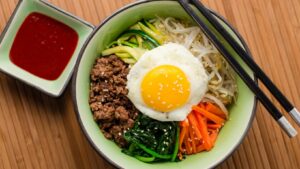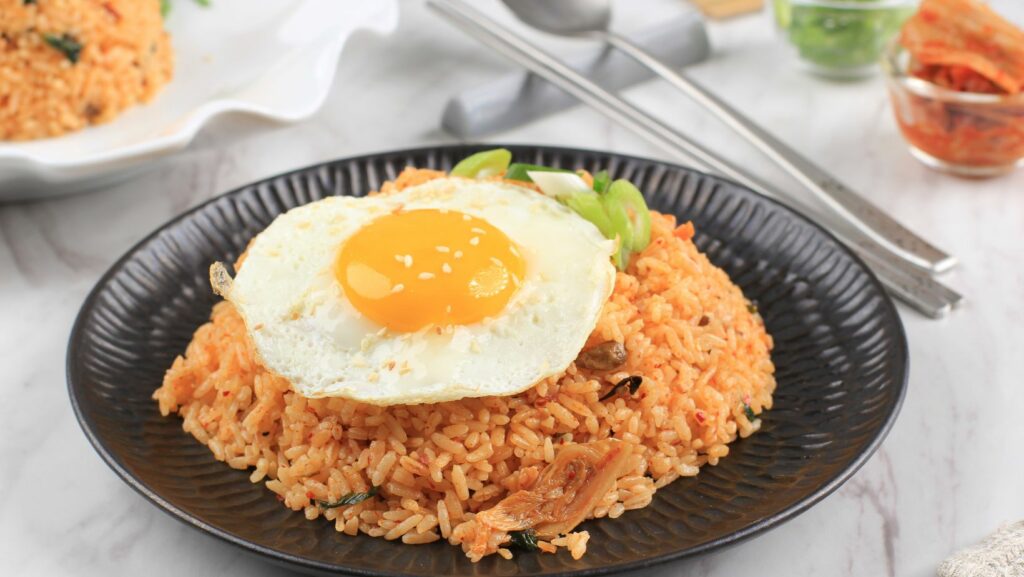Immerse yourself in the world of Korean cuisine, a vibrant fusion of flavors that doesn’t skimp on health benefits. This article will guide you through some of the most delicious and nutritious Korean recipes, showcasing how food can be both a delight for the senses and a boon for the body.
Korean Healthy Recipes
 Korean cuisine exemplifies a harmonious balance of flavors. This balance arises from the skillful blending of five basic food groups. Grains, like rice, offer a wholesome foundation that’s often complemented by proteins such as fish, meat, and legumes. Fruits and vegetables provide refreshing bites throughout, and seaweed contributes an undeniable umami depth.
Korean cuisine exemplifies a harmonious balance of flavors. This balance arises from the skillful blending of five basic food groups. Grains, like rice, offer a wholesome foundation that’s often complemented by proteins such as fish, meat, and legumes. Fruits and vegetables provide refreshing bites throughout, and seaweed contributes an undeniable umami depth.
Harmony in Korean dishes also reflects in the five fundamental flavors: sweet, sour, salty, spicy, and bitter. The savory bulgogi, a marinated beef dish, perfectly embodies this balance with its contrasting sweet and salty taste, while the fiery kimchi utilizes a combination of spice, sour notes, and a slight hint of sweetness to create a flavor burst that’s exhilarating.
Moreover, Korean recipes employ the principle of yin and yang. It implies deploying ingredients with hot (yang) or cool (yin) energies to maintain an equilibrium. Examples include a hot bibimbap dish served with cool cucumber and radish pickles. These factors combined create a palatable experience that allows Korean cuisine to stand out for its healthy, flavorful dynamism.
Korean Healthy Recipes for Breakfast
 Building on the harmonious balance that Korean cuisine is renowned for, promoting a healthy and balanced lifestyle starts with breakfast. The Juk, a traditional Korean breakfast, provides a nutritionally balanced start to the day. In its basic form, Juk consists of rice porridge often accompanied by small dishes of fermented vegetables, like kimchi. However, Juk can also feature a variety of proteins such as chicken -forming Dakjuk, or abalone – becoming Jeonbokjuk.
Building on the harmonious balance that Korean cuisine is renowned for, promoting a healthy and balanced lifestyle starts with breakfast. The Juk, a traditional Korean breakfast, provides a nutritionally balanced start to the day. In its basic form, Juk consists of rice porridge often accompanied by small dishes of fermented vegetables, like kimchi. However, Juk can also feature a variety of proteins such as chicken -forming Dakjuk, or abalone – becoming Jeonbokjuk.
Haemul Pajeon, or seafood and green onion pancake, also serves as a stunning breakfast recipe in Korea. This dish combines the savory tastes of seafood with the freshness of spring onions, striking a delightful balance between sweet and salty, whilst packed with proteins and greens. Hence, it provides a perfectly balanced, healthful start to the day.
Wholesome Korean Recipes for Lunch
Transitioning from an energizing breakfast, it’s essential to maintain a nutritious momentum during lunchtime, epitomized by Korean culinary customs. An example is Bibimbap, a popular Korean dish offering a perfect combination of ground beef, a mix of veggies, and rice, drizzled with a savory Gochujang sauce. It marries elements of yin and yang, infusing a burst of balanced flavors.
Tteokbokki, a Korean rice cake topped with a fiery, aromatic Gochujang sauce, stands as an ideal fit for someone craving a healthy yet satisfying lunch. These dishes, like their breakfast counterparts, denote a commitment to nutrient balance, striking a chord with those seeking substantial, hearty meals. Links to detailed recipes, cooking instructions, and nutritional facts help bring these dishes to your table.
Nutritious Korean Recipes for Dinner
 Transitioning from breakfast and lunch, explore the world of healthy Korean recipes meant for dinner. Master the art of preparing Soondubu Jjigae, a soft tofu stew rich in protein and packed with heart-warming flavors. Try Japchae, a classic Korean dish where glass noodles unite with mixed vegetables to create a feast of nutrients and colors. Let’s not forget about Doenjang Jjigae, a savory soybean paste stew offering a fusion of protein-packed tofu and various vegetables contributing to the daily fiber intake.
Transitioning from breakfast and lunch, explore the world of healthy Korean recipes meant for dinner. Master the art of preparing Soondubu Jjigae, a soft tofu stew rich in protein and packed with heart-warming flavors. Try Japchae, a classic Korean dish where glass noodles unite with mixed vegetables to create a feast of nutrients and colors. Let’s not forget about Doenjang Jjigae, a savory soybean paste stew offering a fusion of protein-packed tofu and various vegetables contributing to the daily fiber intake.
Venture into the variety of Korean BBQ options such as Samgyeopsal, where grilled pork belly provides high-quality protein and when paired with fresh lettuce wraps and assorted sides, forms a well-rounded meal. Finally, experience Haemul Jeongol, a spectacular seafood hot pot rich in omega-3 fatty acids, making it an ideal heart-healthy dinner choice.
In each of these dishes, you’ll find a balance of flavors and nutrients, embodying the principles of yin and yang in Korean cuisine. Detailed recipes, cooking instructions, and nutritional facts accompany each dish for easy at-home preparation.

